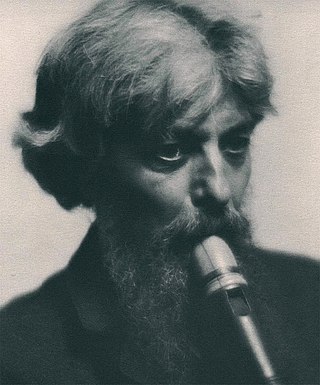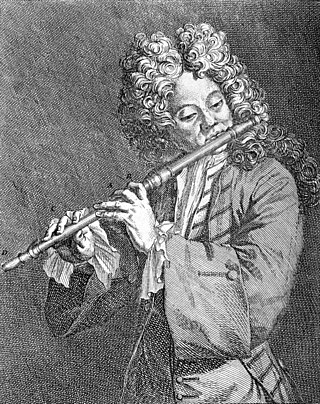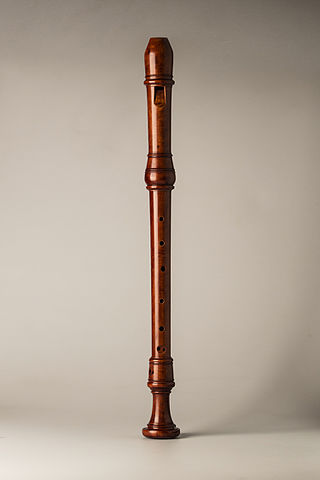Related Research Articles

Antoine-Joseph "Adolphe" Sax was a Belgian inventor and musician who invented the saxophone in the early 1840s, patenting it in 1846. He also invented the saxotromba, saxhorn and saxtuba. He played the flute and clarinet.

The recorder is a family of woodwind musical instruments in the group known as internal duct flutes: flutes with a whistle mouthpiece, also known as fipple flutes. A recorder can be distinguished from other duct flutes by the presence of a thumb-hole for the upper hand and seven finger-holes: three for the upper hand and four for the lower. It is the most prominent duct flute in the western classical tradition.

The National Music Museum: America's Shrine to Music & Center for Study of the History of Musical Instruments (NMM) is a musical instrument museum in Vermillion, South Dakota, United States. It was founded in 1973 on the campus of the University of South Dakota. The NMM is recognized as "A Landmark of American Music" by the National Music Council.
A multiphonic is an extended technique on a monophonic musical instrument in which several notes are produced at once. This includes wind, reed, and brass instruments, as well as the human voice. Multiphonic-like sounds on string instruments, both bowed and hammered, have also been called multiphonics, for lack of better terminology and scarcity of research.

Eugène Arnold Dolmetsch, was a French-born musician and instrument maker who spent much of his working life in England and established an instrument-making workshop in Haslemere, Surrey. He was a leading figure in the 20th-century revival of interest in early music.
The Ruckers family were harpsichord and virginal makers from the Southern Netherlands based in Antwerp in the 16th and 17th century. Their influence stretched well into the 18th century, and to the harpsichord revival of the 20th.

A rauschpfeife is a capped conical reed musical instrument of the woodwind family, used in Europe in the 16th and 17th centuries. In common with the crumhorn and cornamuse, it is a wooden double-reed instrument with the reed enclosed in a windcap. The player blows into a slot in the top of the windcap to produce the sound.

The Bate Collection of Musical Instruments is a collection of historic musical instruments, mainly for Western classical music, from the Middle Ages onwards. It is housed in Oxford University's Faculty of Music near Christ Church on St. Aldate's.

Jacques-Martin Hotteterre, also known as Jacques Martin or Jacques Hotteterre, was a French composer and flautist who was the most celebrated of a family of wind instrument makers and wind performers.

Classical music generally refers to the art music of the Western world, considered to be distinct from Western folk music or popular music traditions. It is sometimes distinguished as Western classical music, as the term "classical music" also applies to non-Western art music. Classical music is often characterized by formality and complexity in its musical form and harmonic organization, particularly with the use of polyphony. Since at least the ninth century it has been primarily a written tradition, spawning a sophisticated notational system, as well as accompanying literature in analytical, critical, historiographical, musicological and philosophical practices. A foundational component of Western culture, classical music is frequently seen from the perspective of individual or groups of composers, whose compositions, personalities and beliefs have fundamentally shaped its history.

The Royal Conservatory of Brussels is a historic conservatory in Brussels, Belgium. Starting its activities in 1813, it received its official name in 1832. Providing performing music and drama courses, the institution became renowned partly because of the international reputation of its successive directors such as François-Joseph Fétis, François-Auguste Gevaert, Edgar Tinel, Joseph Jongen or Marcel Poot, but more because it has been attended by many of the top musicians, actors and artists in Belgium such as Arthur Grumiaux, José Van Dam, Sigiswald Kuijken, Josse De Pauw, Luk van Mello and Luk De Konink. Adolphe Sax, inventor of the saxophone, also studied at the Brussels Conservatory.
Barthold Kuijken is a Belgian flautist and recorder player, known for playing baroque music on historical instruments and particularly known for pioneering this manner of performance with his brothers, cellist and viol player Wieland Kuijken and violinist Sigiswald Kuijken, and the harpsichordist Gustav Leonhardt.

The Musical Instruments Museum (MIM) is a music museum in central Brussels, Belgium. It is part of the Royal Museums of Art and History (RMAH) and is internationally renowned for its collection of over 8,000 instruments.

Moeck Musikinstrumente + Verlag is a leading German manufacturer of recorders and a music publisher.

The Lobkowicz Palace is a part of the Prague Castle complex in Prague, Czech Republic. It is the only privately owned building in the Prague Castle complex and houses the Lobkowicz Collections and Museum.

The tenor recorder is a member of the recorder family. It has the same form as a soprano recorder and an alto recorder, but it produces a lower sound than either; a still lower sound is produced by the bass recorder and great bass recorder.

The voice flute (also the Italian flauto di voce and the French flûte de voix are found in English-language sources) is a recorder with the lowest note of D4, and is therefore intermediate in size between the alto and tenor recorders.
Friedrich Freiherr von Hoyningen, genannt Huene, known professionally as Friedrich Alexander von Huene, was an American recorder maker.
Peter Bressan was a noted woodwind instrument maker of whose work several examples exist in museums and private collections.

Peter Harlan was a German multi-instrumentalist and musical instrument maker. In the 1920s he was an employee of the Munich magazine Der Gitarrenfreund.
References
- 1 2 3 Stefaan Ottenbourgs (2001). "Rottenburgh". Grove Music Online . Oxford Music Online. Oxford University Press. doi:10.1093/gmo/9781561592630.article.23945.
- ↑ Richard W. Griscom, David Lasocki (2013). "Rottenburgh family". The Recorder: A Research and Information Guide. Taylor & Francis. p. 140. ISBN 9781135839321.
- ↑ Pratt, Bill (February 1973). "Dr. Hermann Moeck Talks About His Firm". The American Recorder. American Recorder Society. 14 (1): 3–8.